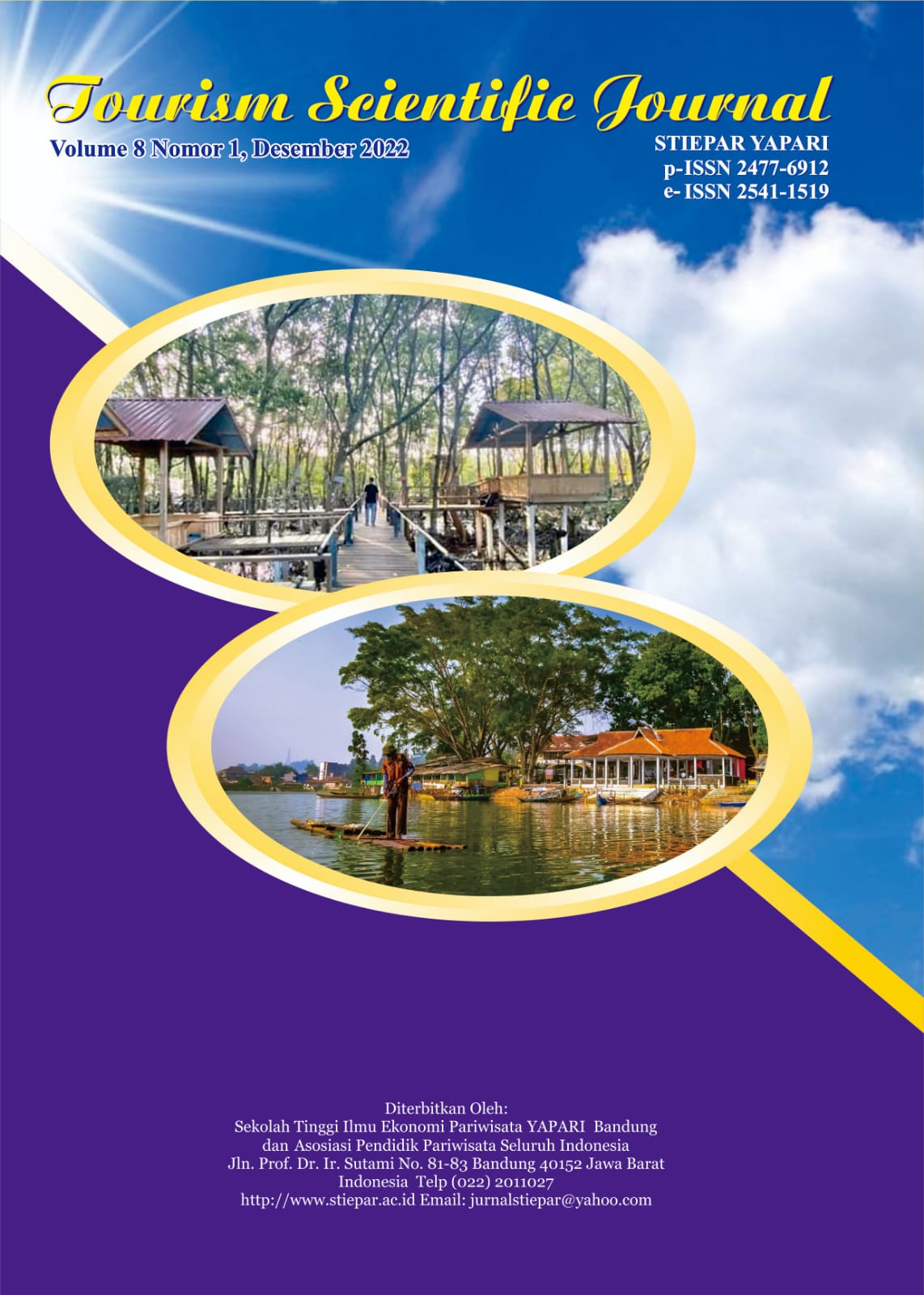Studi Perencanaan dan Pengembangan Objek Wisata Danau (Studi Kasus Situ Ciburuy)
DOI:
https://doi.org/10.32659/tsj.v8i1.235Keywords:
Strategy, Planning, Sustainable development, SWOTAbstract
This study aims to determine the actual conditions (physical and non-physical) aspects of lake tourism development, to know the policy analysis of Situ Ciburuy tourism object development as a lake tourism development planning strategy, to know Situ Ciburuy tourism activities and market analysis of Situ Ciburuy tourism products as a lake tourism development planning strategy and know the planning strategy for sustainable tourism development in the context of developing lake tourism. The research is qualitative in nature, using primary data through observation, interviews and secondary questionnaires through documents and scientific journals. The analytical method used is SWOT analysis which identifies various factors to formulate a strategy. Based on the SWOT analysis of internal and external strategic factors. Situ Ciburuy internally has a strength value that is greater than its weakness, while externally it has an opportunity value that is greater than its threats. strength factors maximize the utilization of all opportunities. The recommended strategy is making a master plan for the Situ Ciburuy area as a guideline for spatial planning or land allotment and collaborating with investors in increasing the quality and quantity of objects and tourist attractions in the Situ Ciburuy area so as to increase the number of visitors in the future.
References
Black, James. 1999, Metoda dan Masalah Penelitian Sosial, PT. Refika Aditama, Bandung
Butler R. 1992. Alternative Tourism : The Thin Edge of the Wedge, dalam Smith dan Eadington (1992) Tourism Alternative, Potentials and Problems in The Development of Tourism. University of Pensylavinia, Philadelphia.
Clarke J & Godfrey K. 2000, The Tourism Development Handbook : A Practical Approach To Planning and Marketing. Continuum, London.
Dahuri. R, Rais J; Ginting SP; Sitepu. 2001, Pengelolaan Sumber Daya Wilayah Pesisir dan Lautan Secara Terpadu. PT. Pradnya Paramita, Jakarta.
Fandeli, Chafid, 2002, Perencanaan Kepariwisataan Alam. Fakultas Kehutanan Gajah Mada. Pustaka Pelajar, Yogyakarta.
Goeldner R, Ritchie B.R.J; McIntosh W.R. 2000, Tourism : Principles, Practices, Philosophies. Jon Willey & Sons, Canada.
Gunn C. 1994, Tourism Planning; Basic, Concepts and Cases, Taylor and Francis, USA. Hidayat, Marceilla. 2016. Strategi Perencanaan dan Pengembangan Obyek Wisata (Studi Kasus Pantai Pangandaran Kabupaten Ciamis Jawa Barat)”, Tourism & Hospitality Essentials Journal 1.1
Kustiawan. Irwan Kustiawan. 2017. “ STRATEGI PENGEMBANGAN KAWASAN WISATA SITU CIBURUY KABUPATEN BANDUNG BARAT”. - repo unpas
Inskeep Edward, 1998, Guide for local Authorities on Developing Sustainable Tourism.
Maulana Yusuf.. 2019. Implementasi Kebijakan Perda No. 7 Tahun 2013 Tentang Penyelenggaraan Kepariwisataan Daerah Kabupaten Bandung Barat. Skripsi. Universitas Islam Negeri Sunan Gunung Djati.
Oka A. Yoeti, Oka A. 2015. Perencanaan dan pengembangan pariwisata, Pradnya Paramita
Pemerintah Kabupaten Bandung Barat. 2019. RUTR Kawasan Situ Ciburuy,
. 2013. Peraturan Daerah Nomor 7 Tahun 2013 Tentang Penyelenggaraan Kepariwisataan Daerah Kabupaten Bandung Barat
. RENSTRA (Rencana Strategik) Tahun 2020 – 2025, Dinas Pariwisata dan Kebudayaan Kabupaten Bandung Barat
Perspective. Department of Geography Series, University of Waterloo.
Shaleh, Abdul Rosyad, 2013. Manajemen Dakwah Islam, Jakarta: Bulan Bintang, Jakarta
Suwantoro., Gamal. 2015. Dasar Dasar Pariwisata Edisi 4, Cet. 1: Andi. Yogyakarta Woodley, Alison. 1993. Tourism and Sustainable Development : The Community Republik Indonesia. UU No. 23 Tahun 2014 tentang Otonomi Daerah
WTO, World Tourism Organization Agenda 2, 1992. https://www.unwto.org/sustainable-development
Downloads
Published
How to Cite
Issue
Section
Citation Check
License
Copyright (c) 2022 Rieke Sri Rizki Asti Karini, Rachmat Astiana

This work is licensed under a Creative Commons Attribution-ShareAlike 4.0 International License.
-
Attribution — You must give appropriate credit, provide a link to the license, and indicate if changes were made. You may do so in any reasonable manner, but not in any way that suggests the licensor endorses you or your use.
-
ShareAlike — If you remix, transform, or build upon the material, you must distribute your contributions under the same license as the original.












